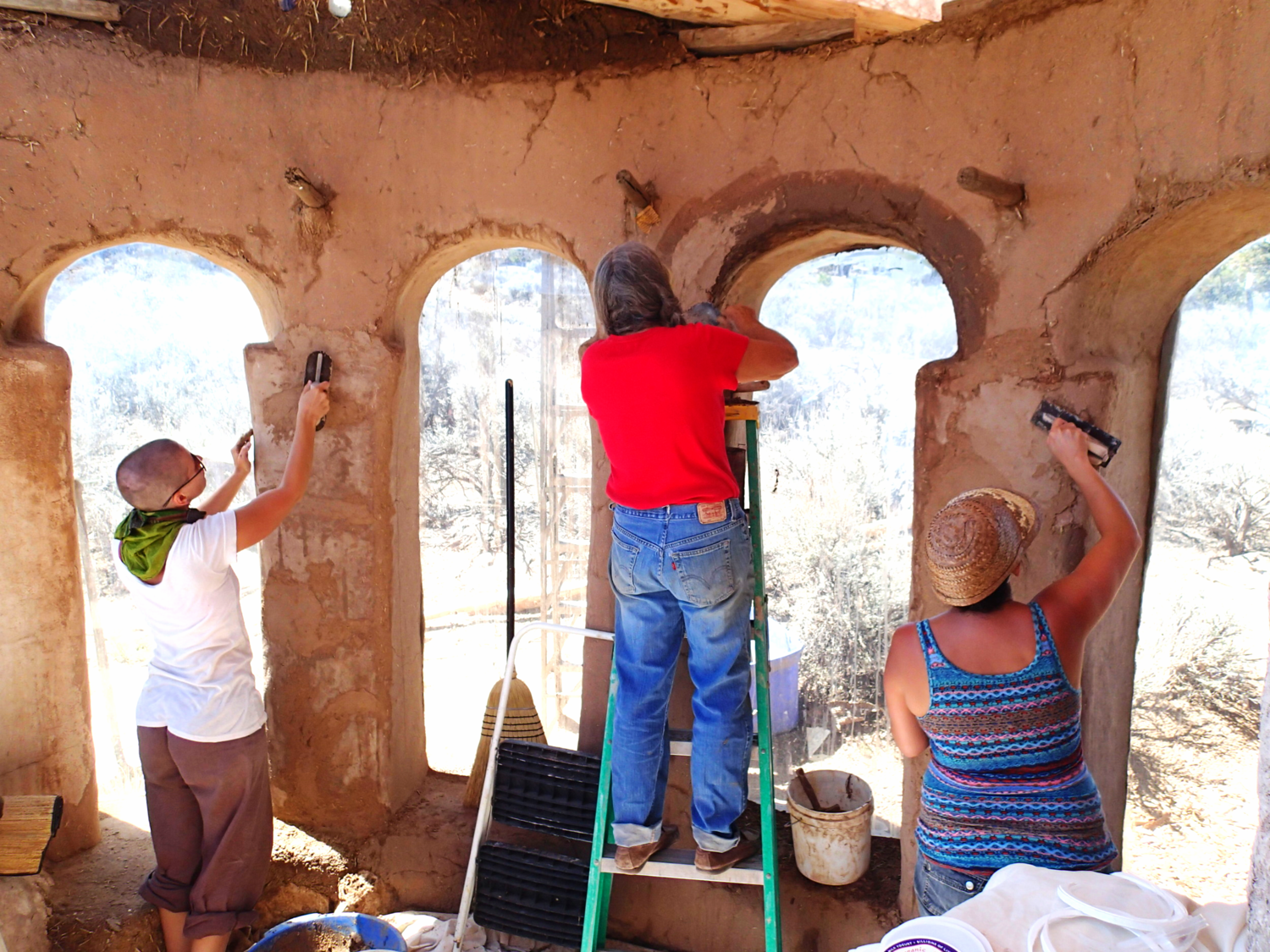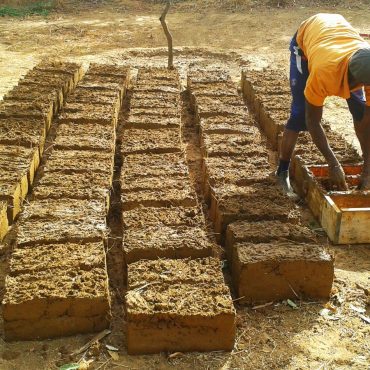
Three simple ways of testing your soil
Soil testing is a task that seems daunting to many people who are new to earth restoration projects or even folks who want to start a garden. Maybe you’ve read […]


No matter what material you build your house with, the finishes will always be the most visible part both inside and out.
For thousands of years people have used natural materials to improve the appearance of their buildings, to protect their buildings from the elements, and to hide the rougher qualities of their walls.
Despite advances in technology and industrial methods of production, most houses are still finished with natural plasters and renders.
In this article we’ll explore the three most common types of plaster, discuss their benefits and limitations, and talk about why they’re the best option for home finishings, not only in natural homes, but in conventional homes too.
Natural earthen plasters fall into three main categories, clay, lime, and gypsum.
Clay plasters are the most versatile of the three because its wide range of applications and the ubiquity of the material which makes it affordable and easy to obtain.
Clay sub-soils can be found almost everywhere in the world, and are often free to excavate yourself.
They can be used in indoor and outdoor settings, to make sculptures and relief carvings, and are easy to maintain.
Clay based plasters can be made with clay rich subsoil or purchased clay that has been refined.
It doesn’t require any heating or processing and can be mixed with other binders, fibers, and pigments to enhance its inherent durability and aesthetic qualities.
It is also fire proof, mold resistant, and visually pleasing.





Lime plaster is another great example of a beautiful and very durable finish.
It is made by heating limestone (calcium carbonate) to transform it into a product called quicklime (calcium oxide).
It is then re-hydrated to form slaked lime (calcium hydroxide) and the resulting putty is the base for lime plaster.
Once the plaster has been applied it goes through a chemical process when it comes into contact with carbon dioxide in the air and gradually turns back into calcium carbonate (limestone).
This curing process can take up to a century, during which the plaster becomes harder with each passing year.
For this reason, lime plaster has been used as a durable and weather resistant finish for millennia.
One important thing to know about processed lime is that it is caustic and can harm your skin if you are exposed to it before it cures.
These same caustic properties however, make it highly resistant against mold and bacteria.




Gypsum plasters (also known as Plaster of Paris) are very common in modern use with the proliferation of drywall. Gypsum plaster is made by heating raw gypsum to 300F (150C) to change its chemistry.
Adding water to the plaster creates the pliable paste which reforms into gypsum as it dries.
Gypsum plaster usually sets in about 45 minutes after mixing but takes about 72 hours to completely cure.
It is however, very weak against water and should only be used in dry indoor settings and will likely perform poorly in places like bathrooms and kitchens if it isn’t protected by a secondary finish.
There are tons of reasons why natural plasters are the best choice for building finishes.
To begin with, earthen plasters can actually improve your health.
They are entirely non-toxic, contain no VOC’s (volatile organic compounds), and clay and lime even resist mold growth.
An often overlooked and subtle benefit of clay is that when it comes into contact with water it emits a negative charge.
These negative ions which are released into the air help humans to absorb oxygen which increases energy.
This also helps to counteract the positive charges and ions that are emitted by home electronics and certain plastics which have a damaging effect on our bodies.
Because all of these varieties of plaster are porous, which allows the plasters to “breath” by absorbing moisture and humidity, they help to control the interior climate and air quality of a building.
This helps to regulate temperature and to prevent the growth of mold and bacteria in the home.
Especially in the case of clay, this respiration can absorb and dissipate odors and even filter toxins in the air.
On top of the health benefits natural plasters are inherently environmentally friendly and have a low embodied energy in their production.
Natural plasters are also affordable, durable and easy to repair.
Anyone can learn to mix and apply them.
Lastly, all earthen plasters are fire retardant which helps to improve the safety of the home.
The anatomy of a plaster mix consists of three main categories of materials: binder, structure, and fiber.
Plasters are usually defined by their binders which are the glue that holds the mix together.
Lime, clay, and gypsum, are the dominant binders, but other secondary binders such as wheat paste, manure, and cactus juice can be added to enhance the performance of the finish.
The structure is what gives the plaster its “body,” and makes up the majority of the mix.
Usually made up of sand, structure can determine the type and intent of the plaster based on its size of grit.
For rough scratch coats a coarser sand is used, and for final coats, finer grit is ideal for a smooth finish.
Different stable powders can also be used for different effects. Fiber can provide tensile strength to the mix which allows for a thicker application or even sculptural build outs.
It also helps to prevent cracking in the final effect. Fiber, however, is not usually used in finished coats except for aesthetic reasons.
It is very important to mix your plasters with the correct ratio of ingredients in order to guarantee good performance.
In the case of lime and clay plasters, the bulk of the mix will be sand. Too much sand will make for a brittle and crumbly finish, but without enough, the plaster will crack and powder.
Fibers help to hold thicker applications together, but if too much is added or improperly mixed the plaster will be lumpy and hard to work with.
Fibers can also show through and roughen thinner applications, and in most cases they are unnecessary in finishing applications.
Different properties of each plaster make them better suited for certain applications.
Lime works really well in places that sustain tough weather conditions. It can also be made water-proof, and is generally good for bathrooms and showers, or anywhere that gets a lot of humidity or moisture.
However, lime can be expensive or hard to get depending on where you live. Because it is caustic, precautions and protections must be taken when working with it.
Gypsum is good for smooth and aesthetic finishes, but not well suited for bulkier scratch coats. It is cheap and can be bought ready-made and also sets quickly.
The downside is that it is unsuitable anywhere with much moisture, such as humidity and back-splash, and for exterior applications.
Clay is the most ecologically friendly and versatile of the three. It can be used for both exterior and interior applications.
Though it will need to be maintained more often than lime plaster when used as an exterior render, any erosion can be mitigated by protecting the exterior walls with larger roof eaves and higher foundations.
Clay is easy and safe to work with and can often be found on site and mixed by hand. It also has many benefits for the interior environment and is very flexible and easy to repair.
Though many of the same materials are used in the mixes for both interior and exterior plasters, there are some additives and differences in the application technique that can make them perform better for each purpose.
Exterior plasters, also known as “renders,” are used to cover and protect the outside walls of a structure.
For this reason, they need to be durable enough to repel wind, rain, and snow, and must also be easy to maintain.
The strongest natural plaster for exteriors is lime because of its durability against water.
Being less porous and harder-curing than either clay or gypsum, lime will require the least amount of maintenance over time and can often be maintained simply by applying a new coat of lime wash each year.
Clay and lime plasters can also be made more durable with the addition of other binders and oils.
Manure, wheat paste, and casein wash are commonly added to clay plasters to make them more durable.
Linseed oil can also be added to both clay and lime plasters to increase their water resistance, however, with the addition of oil, plasters can be harder to maintain, because when they are damaged it is difficult to get the new layer of plaster to properly adhere to the old one.
Since the invention of portland cement, and its wide adoption after WWII, many natural finishes have been replaced with cement stucco.
Because of its durability and weather proof qualities, it was, and often still is, thought to be an appropriate replacement for lime and clay renders.
Only in the last few decades have we been able to see the hidden damage that cement stucco does to earthen walls and why it makes for a poor quality finish.
The main difference is that natural plasters are porous and can breathe, allowing moisture and humidity to pass slowly through the finishes.
Cement cannot do this, and acts as a vapor barrier that causes moisture to accumulate on one side of the render and then starts to erode the wall from the inside.
There are many examples of buildings that stood for hundreds of years needing only routine maintenance on the plasters to remain strong, but once they were covered in cement stucco they sustained major water damage and nearly collapsed, such as the case with the San Francisco de Assisi church in Ranchos, NM,
Interiors plasters don’t have to contend with the same forces of nature as those on the outside, but they still need to perform certain functions and be relatively durable.
The main concern for earthen plasters in interior spaces is dusting.
Dusting and powdering can occur predominantly in lime plasters that haven’t cured correctly, and clay plasters that were applied poorly or were mixed with incorrect ratios.
Lime must be allowed to dry very slowly, sometimes over the course of one or two weeks, in order to prevent cracking and powdering.
Powdering in clay plasters can be prevented with the addition of manure, wheat paste and casein wash (much like for exterior applications), and also by compressing the plaster after it is “leather hard.”
All kinds of effects and colors can be achieved with any natural finish by adding pigments or minerals, and by changing the application technique. Each of the three main types of plasters can be used to create relief sculptures and carvings in walls as well.
Lime plaster can be painted with water soluble paints to create frescoes in the same way the the Sistine Chapel was done.
Another beautiful and functional finish that can be made from lime is called Tadelakt. Tadelakt is a traditional plastering effect from Morocco that consists of using a layer of lime that is burnished with smooth river stones and polished multiple times with olive oil soap to create a waterproof cover.
It was used for hundreds of years for the interior of bath houses and has gained popularity in modern times for uses in bathrooms and even sinks and bathtubs.



In conclusion, natural plasters offer many benefits both inside and outside of a structure.
They are easy to work with, non-toxic, and environmentally friendly. They can help to improve the health of interior spaces by regulating humidity, and filtering the air.
The materials to make earthen plasters are easily found and affordable too. The process of mixing and applying the plasters is easy to learn and safe to work with.
You can easily experiment with different colors and effects by mixing small batches at home and applying little “test patches” to a wall to see how the finish will turn out.
Natural finishes can greatly enhance the look and feel of any home whether it’s a natural or earthen home, or even conventional and industrial buildings. We hope you’ll consider natural plasters for the finish of your next project.
Tagged as: Articles.

Soil testing is a task that seems daunting to many people who are new to earth restoration projects or even folks who want to start a garden. Maybe you’ve read […]



Copyright Regenerative Skills 2021
combatant on February 20, 2020
Ꮋey there! I’ve been following your weblog for a wһile now and fіnally got
the bravery to go ahead and givе you a shout out from
Lubƅocк Tx! Just wanted to say keep up the excellent job!
Oliver on February 21, 2020
Hey Zara, thanks so much for your support. I really appreciate it. Feel free to reach out any time if you have any suggestions for contact too. Hope things are well in TX
Exterior Plastering Christchurch on May 8, 2020
This is a brilliant post, thank you for sharing these great tips. I think you are right with mentioning the earthen plaster: the healthiest and most beautiful way to finish your home. I am sure many people will come to read this in future. I must say this, if you get time can visit ptcladding.co.nz for ideas on this topic.